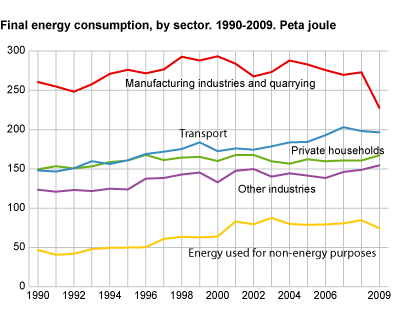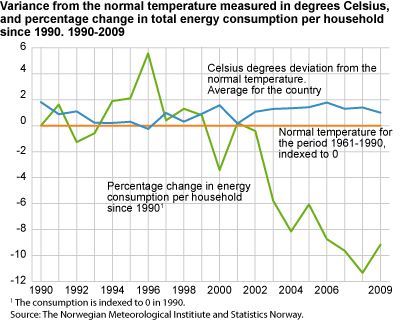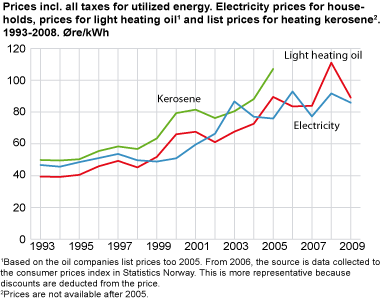Content
Published:
This is an archived release.
Economic recession led to lower energy consumption
The total energy consumption in 2009 was 4 per cent lower than the previous year and the lowest consumption since 1996. The reduction can be related to the financial crisis that started in autumn 2008 and contributed to a significant drop in the international economy.
The total energy consumption, excluding energy used for non-energy purposes, made up 746 peta joule in 2009.
The financial crisis hit the electricity intensive manufacturing industries particularly hard because these industries export a high share of their products. Lower international demand contributed to reduced prices of, among other things, steel and aluminium in 2008/2009. This resulted in reduced production and electricity consumption, and also some shut downs in industries producing metal, and paper and paper products. The energy consumption in metal and paper/paper product manufacturing dropped by 18 and 16 per cent respectively from the previous year. These industries make up more than 60 per cent of the total energy consumption in manufacturing industries and normally above 20 per cent of our total energy consumption. The total energy consumption in manufacturing industries dropped by 17 per cent from 2008 to 2009.
Lower energy consumption in transport
Domestic consumption for transport purposes in 2009, such as road transport, railway, air and coastal transport, dropped by about 1 per cent from the previous year. This is mainly due to a reduction in road transport of 2 per cent from 2008. It was particularly gasoline consumption that fell, for the ninth year in succession.
Lower energy consumption of most kinds of energy commodities
We reduced our consumption of oil products, electricity, gas and biomass from 2008 to 2009, but the consumption of electricity in particular fell considerably, by 6 per cent from 2008. On the other hand, consumption of district heating increased by about 13 per cent. We can expect further growth in district heating due to record high investments in district heating in 2009. For the time being, district heating does not constitute more than about 1.5 per cent of our total energy consumption.
High share of renewable energy consumption in Norway
Our total energy consumption (excl. energy used for non-energy purposes) was spread over electricity, oil products and fuel wood, with about 51, 36 and 6 per cent respectively in 2009. The remaining 7 per cent was made up of coal, coke and district heating. Because our energy consumption to a large degree is based on hydro power, a high share of our energy consumption is renewable. This means that it comes from energy sources with a continuous entry of new energy, such as hydro power and biomass. Norway’s renewable energy share of total energy consumption made up 62 per cent in 2008, when calculated according to the EU’s renewable energy directive. The renewable energy share in the EU was only 10.3 per cent on average in 2008, while the 2009 figures have not been calculated yet.
This renewable energy directive was approved in the EU in 2009. Because it is relevant to the EEA, Norway is for the time being also in negotiations with the EU concerning implementation of the directive. The appendix table 15 shows the development in renewable energy for Norway, but it doesn’t follow the EU’s method, and the results from these methods are not consistent.
More gas power
Normally, hydro and wind power have made up about 98-99 per cent of Norway’s total electricity production, but in 2009, this share fell to about 96 per cent due to higher gas power production. The gas power production on the LNG plant on Melkøya in Hammerfest is included in the production figure for electricity in 2009, but has not been included earlier. This plant started up in 2007. Furthermore, there was a significant increase in electricity production in the gas power plant Naturkraft on Kårstø, probably due to the larger drop in the gas price than in the electricity price in 2009 making gas power production more profitable. The amount of natural gas used in thermal power plants increased tenfold from 2008 to 2009, mainly due to these two plants.
Colder weather led to higher energy consumption in households and services
In households and services, the energy consumption in 2009 rose by 4 per cent compared to the previous year. This is partly due to the fact that it was somewhat colder in 2009 than in 2008. On the whole, it has been warmer than normal in the last 20 years, but there are some variations in the temperature from year to year. The temperature in 2009 was 1oC above the climatic normal for the period 1961-1990 and 1.4oC above normal in 2008. However, some of the winter months in 2009 were colder than the previous year. Consumption of electricity, district heating and fuel wood in households rose by 4 per cent from 2008 to 2009, while the households’ energy consumption was unchanged from 1995 to 2008.
The price of light heating oil dropped from the record high NOK 8.9 per litre in 2008 to NOK 7.1 per litre in 2009. Converted to a price of utilised energy, this corresponds to 89 øre/kWh, which is approximately the same as for electricity. The reduction in the heating oil price can be related to the fact that the crude oil price collapsed from July 2008 due to the economic recession. The crude oil price fell from 130 USD/barrel in the first six months of 2008, to about 40 USD at the end of the year, and was still relatively low in the first months in 2009. A reduction in the prices of fossil fuels contributed to lower electricity prices since this is an important cost component in the production of thermal power. The electricity prices in the electricity spot trading market dropped from 2008 to 2009, and this also affected the end user prices. The electricity price to households fell from 92 øre/kWh in 2008 to 86 øre/kWh in 2009. The reduction in energy prices can be related to lower energy demand as a result of the financial crisis.
Lower global energy consumption
According to, amongst other sources, BP Statistical Review of World Energy, the total world energy consumption fell in 2009 for the first time in many years, due to the global economic recession. The energy consumption was mainly reduced in OECD countries. In several developing and Asiatic countries the energy consumption continued to increase also in 2009.
Tables:
- Table 1 Energy sources balance sheet for Norway. 2009. Preliminary figures.
- Table 2 Energy balance sheet for Norway. 2009. Petajoule.
- Table 3 Energy balance sheet for Norway. 2009. GWh. Preliminary figures.
- Table 4 Energy accounts. Extraction, conversion and use of energy goods. 2009. Preliminary figures
- Table 5 Energy accounts. Use of energy goods outside the energy sectors, by industry. 2009. Preliminary figures
- Table 6 Energy accounts. Extraction, conversion and use of energy goods. 2009. Preliminary figures. PJ
- Table 7 Energy accounts. Extraction, conversion and use of energy goods. 2009. Preliminary figures. GWh
- Table 8 Energy sources balance sheet for Norway. 2008.
- Table 9 Energy balance sheet for Norway. 2008. Petajoule.
- Table 10 Energy balance sheet for Norway. 2008. GWh
- Table 11 Energy accounts. Extraction, conversion and use of energy goods. 2008
- Table 12 Energy accounts. Use of energy goods outside the energy sectors, by industry. 2008
- Table 13 Energy accounts. Extraction, conversion and use of energy goods. 2008. PJ
- Table 14 Energy accounts. Extraction, conversion and use of energy goods. 2008. GWh
- Table 15 Energy use in Norway 1998-2009, exclusive international maritime transport and commodities used as raw materials. Renewable and non-renewable energy. TWh and per cent.
- Table 16 Net consumption of individual energy bearers. 1976-2009.
- Table 17 Energybalance 1998- 2009*. Petajoule.
- Table 18 Percentage share of energy consumption, by individual energy carriers. 1998-2009*.
- Table 19 Energy consumption in households, incl. holiday cottages. 1990-2009*
- Table 20 Energy consumption in households and holiday cottages. 1990-2009*. GWh.
- Table 21 Average electricity prices and list prices of selected petroleum products. Excluding and including taxes. 1993-2009.
- Table 22 Calculated prices of utilized energy. 1978-2009. Fixed 1998-prices. øre/kWh. All taxes included
- Table 23 Energy balance, total energy 1998-2009. GWh
- Table 24 Supply and use of electricity 1998-2009. GWh
The statistics is now published as Production and consumption of energy, energy balance and energy account.
Additional information
The statistics are published in spring and autumn. The spring publication is preliminary and aggregated to a larger degree, and only includes figures for energy balance. In the autumn publication, tables are also presented for the energy accounts.
Contact
-
Statistics Norway's Information Centre
E-mail: informasjon@ssb.no
tel.: (+47) 21 09 46 42



